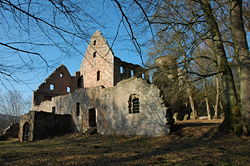Schönrain Priory
| Kloster Schönrain | |

The ruins in 2006
|
|
| Monastery information | |
|---|---|
| Order | Benedictines |
| Established | circa 1100 |
| Disestablished | 1526 |
| Architecture | |
| Groundbreaking | circa 1100 |
| Site | |
| Location | near Lohr am Main |
| Coordinates | 50°01′50″N 9°39′23″E / 50.03056°N 9.65639°ECoordinates: 50°01′50″N 9°39′23″E / 50.03056°N 9.65639°E |
| Public access | yes |
Schönrain Priory (German: Kloster Schönrain) was a house of the Benedictine Order located near Lohr in the Spessart, in Bavaria in southern Germany. Few signs of the monastic buildings are visible today. The ruins that remain mostly consist of later additions when the structure served as a temporal dwelling and foresters' lodge.
There is a legend that it was founded in the Carolingian period, in about 750, by Saint Lioba, and some have argued that a few traces of architecture from that period survive.
However, firm information on this place is available only from the 11th century, when the monastery, with some property to endow it, was given by Landgraf of Sangerhausen or his sons Berengar and Ludwig to Hirsau Abbey, reportedly after the younger Ludwig had killed Markgraf during a hunt in 1065. After being incarcerated, Ludwig escaped. He founded Reinhardsbrunn Abbey near Coburg and possibly gifted his possession at Schönrain to Hirsau. Around 1100, abbot Wilhelm von Hirsau built the monastery, from which the monks served the whole region between Lohr, Gemünden am Main and Karlstadt am Main.
In 1159, Schönrain swapped property at nearby Massenbuch for Hofstetten (today both are part of Gemünden). The local feudal lords were the Counts of Rieneck, kin of the founders, who persistently over the next centuries tried to acquire the property for themselves. They built a castle nearby to protect the priory. After a power struggle with the Bishop of Würzburg, they had to demolish it in 1243.
In 1376, the Rieneck family sold their local properties to Würzburg, but retained the position of Vögte (or lay stewards) of Schönrain.
...
Wikipedia

